|
|
|
Your search within this document for 'china' resulted in 216 matching pages.
|
| 1 |
 |
New Page
“...An American Engineer
in China...”
|
|
| 2 |
 |
New Page
“...PRESENTED
to the
LIBRARY
of the
SCHOOL OF ORIENTAL AND
AFRICAN STUDIES
University of London
by
.China Association-..............................
..........................................1979..................................................................”
|
|
| 3 |
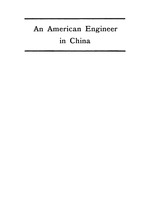 |
Page 1
“...An American Engineer
in China...”
|
|
| 4 |
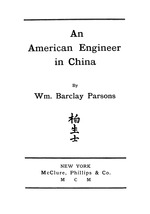 |
Page 3
“...An
American Engineer
in China
By
Wm. Barclay Parsons
NEW YORK
McClure, Phillips & Co.
M C M...”
|
|
| 5 |
 |
Page 5
“...11 Preface
THE following pages are designed to pre-
sent a view of China and the Chinese from
the stand-point of industrial development
as it exists at present and along the lines it is
likely to follow in the future. Such phases of
the Chinese question as the missionary problems,
and the causes and treatment of the recent politi-
cal disturbance, are left entirely to be dealt with
by others, as, likewise, are all matters of govern-
ment, internal and foreign politics, and personal
or national characteristics, except in so far as
they may come within the subject scope. In
the years 1898 and 1899 the author was in China,
under retainer of an American syndicate to ex-
amine, survey, and report on an extensive rail-
way enterprise, and the duties connected with
his professional work placed him in an excep-
tional position to study and observe this interest-
ing country and its people from a quite different
point of view from that taken by other writers.
The journey made in the course of the...”
|
|
| 6 |
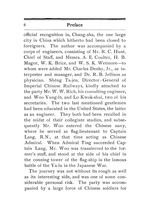 |
Page 6
“...6
Preface
official recognition in, Chang-sha, the one large
city in China which hitherto had been closed to
foreigners. The author was accompanied by a
corps of engineers, consisting of Mr. R. C. Hunt,
Chief of Staff, and Messrs. A. E. Coulter, H. B.
Magor, W. K. Brice, and W. S. K. Wetmoreto
whom were added Mr. Charles Denby, Jr., as in-
terpreter and manager, and Dr. R. B. Jellison as
physician. Sheng Ta-jen, Director General of
Imperial Chinese Railways, kindly attached to
the party Mr. W. W. Rich, his consulting engineer,
and Woo Yung-fo, and Lo Kwok-shui, two of his
secretaries. The two last mentioned gentlemen
had been educated in the United States, the latter
as an engineer. They both had been recalled in
the midst of their collegiate studies, and subse-
quently Mr. Woo entered the Chinese navy,
where he served as flag-lieutenant to Captain
Lang, R.N., at that time acting as Chinese
Admiral. When Admiral Ting succeeded Cap-
tain Lang, Mr. Woo was transferred to the for-
mer's staff...”
|
|
| 7 |
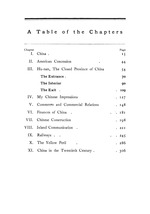 |
Page 9
“...A Table of the Chapte r s
Chapter I. China . Page 15
II. American Concession 44
III. Hu-nan, The Closed Province of China 54
The Entrance . 70
The Interior 90
The Exit 109
IV. My Chinese Impressions . 127
V. Commerce and Commercial Relations . 148
VI. Finances of China . 181
VII. Chinese Construction . 198
VIII. Inland Communication . . 221
IX. Railways . . 245
X. The Yellow Peril . 286
XI. China in the Twentieth Century . . 306...”
|
|
| 8 |
 |
Page 13
“...of the Tartar City, Peking, with One of
the Gate-towers.......214
The Great Wall of China . 216
The Siang Kiang ...... . 224
A Freight-boat Being Poled Against the Stream . 228
A Sail That May Have Seen Better Days, but Which is by
no Means a Unique Specimen ..... 230
A Female Skipper ........ 232
The Equality of Sex. A Man and a Woman at the Oar . 233
A Cantonese Slipper Boat ...... 235
Fast Freight by Wheelbarrow . . 237
The Author Travelling in an Official Chair . 238
Boy Carrying Coal from the Mines to the River . 240
A Typical Road on Top of a Dyke between Rice-fields . 241
A Road Paved with Stone Slabs Showing the Groove Cut
by Wheelbarrows.......242
The Rocket of China and Mr. Kinder . 248
Khojack Tunnel on the Sind-Peshin Railway, India . 268
Japanese Passenger Train . 270
Typical Large Railway Station in Japan . 272
Typical Small Railway Station in Japan . 274
Passengers Getting on a Train in China . 276
Japanese Railway Freight Station .... 278
Second-class Train on the Imperial...”
|
|
| 9 |
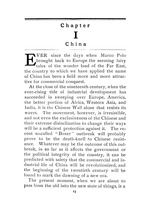 |
Page 15
“...Chapter
i
China
EVER since the days when Marco Polo
brought back to Europe the seeming fairy
tales of the wonder land of the Far East,
the country to which we have applied the name
of China has been a field more and more attrac-
tive for commercial conquest.
At the close of the nineteenth century, when the
ever-rising tide of industrial development has
succeeded in sweeping over Europe, America,
the better portion of Africa, Western Asia, and
India, it is the Chinese Wall alone that resists its
waves. The movement, however, is irresistible,
and not even the exclusiveness of the Chinese and
their extreme disinclination to change their ways
will be a sufficient protection against it. The re-
cent so-called "Boxer" outbreak will probably
prove to be the death-knell to Chinese resist-
ance. Whatever may be the outcome of this out-
break, in so far as it affects the government or
the political integrity of the country, it can be
predicted with safety that the commercial and in-
dustrial life...”
|
|
| 10 |
 |
Page 16
“...16 An American Engineer in China
fitting time to survey the field of industrial enter-
prise by examining into what has been done, and
to ascertain the sort of foundation that has been
prepared 011 which the Chinese people, aided at
first by foreigners, will eventually of themselves
erect their own industrial structure.
In the consideration of this very interesting
land there seems to be a surprise at every turn,
and one of the most peculiar is that we are met at
the outset by the curious circumstance that it is a
country without a name. The Chinese themselves
have no fixed designation for their country, using,
as a general thing, either the Middle Kingdom,"
or the Celestial Kingdom," or the Great Pure
Kingdom." The interpretation of the first is that
the people consider China to be the centre of the
world, all the other countries surrounding and be-
ing tributary to it; although the term probably
originated when, what is now the Province of
Ho-nan was the central kingdom of several other...”
|
|
| 11 |
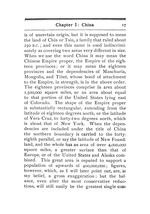 |
Page 17
“...Chapter I : China
17
is of uncertain origin, but it is supposed to mean
the land of Chin or Tsin, a family that ruled about
250 b.c.; and even this name is used indiscrimi-
nately as covering two areas very different in size.
When we use the word China it may mean the
Chinese Empire proper, the Empire of the eigh-
teen provinces; or it may mean the eighteen
provinces and the dependencies of Manchuria,
Mongolia, and Tibet, whose bond of attachment
to the Empire, in strength, is in the above order.
The eighteen provinces comprise in area about
1,500,000 square miles, or an area about equal
to that portion of the United States lying east
of Colorado. The shape of the Empire proper
is substantially rectangular, extending from the
latitude of eighteen degrees north, or the latitude
of Vera Cruz, to forty-two degrees north, which
is about that of New York. When the depen-
dencies are included under the title of China
the northern boundary is carried to the forty-
eighth parallel, or say the latitude...”
|
|
| 12 |
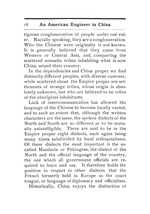 |
Page 18
“...18 An American Engineer in China
tiguous conglomeration of people under one rul-
er. Racially speaking, they are a conglomeration.
Who the Chinese were originally is not known.
It is generally believed that they came from
Western or Central Asia, and, conquering the
scattered nomadic tribes inhabiting what is now
China, seized their country.
In the dependencies and China proper we find
distinctly different peoples, with diverse customs;
while scattered about the Empire proper are set-
tlements of strange tribes, whose origin is abso-
lutely unknown, but who are believed to be relics
of the aboriginal inhabitants.
Lack of intercommunication has allowed the
language of the Chinese to become locally varied,
and to such an extent that, although the written
characters are the same, the spoken dialects of the
North and South are so different as to* be mutu-
ally unintelligible. There are said to be in the
Empire proper eight dialects, each again being
many times subdivided by local colloquialisms...”
|
|
| 13 |
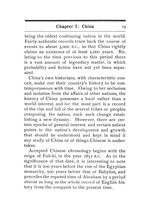 |
Page 19
“...Chapter I : China
9
being the oldest continuing nation in the world.
Fairly authentic records trace back the course of
events to about 3,000 B.C., so that China rightly
claims an existence of at least 5,000 years. Re-
lating to the time previous to this period there
is a vast amount of legendary matter, in which
probability and fiction have not yet been separ-
ated.
China's own historians, with characteristic con-
ceit, make out their country's history to be con-
temporaneous with time. Owing to her seclusion
and isolation from the affairs of other nations, the
history of China possesses a local rather than a
world interest, and for the most part is a record
of the rise and fall of the several tribes or peoples
composing the nation, each such change estab-
lishing a new dynasty. However, there are cer-
tain epochs of general interest and certain salient
points in the nation's development and growth
that should be understood and kept in mind if
any study of China or of things Chinese is...”
|
|
| 14 |
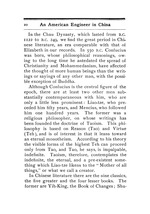 |
Page 20
“...26 An American Engineer in China
In the Chau Dynasty, which lasted from B.C.
1122 to B.C. 249, we find the great period in Chi-
nese literature, an era comparable with that of
Elizabeth in our records. In 550 B.C. Confucius
was born, whose philosophical reasonings, ow-
ing to the long time he antedated the spread of
Christianity and Mohammedanism, have affected
the thought of more human beings than the writ-
ings or sayings of any other man, with the possi-
ble exception of Buddha.
Although Confucius is the central figure of the
epoch, there are at least two other men sub-
stantially contemporaneous with him, who are
only a little less prominent: Liao-tze, who pre-
ceded him fifty years, and Mencius, who followed
him one hundred years. The former was a
religious philosopher, on whose writings has
been founded the doctrine of Taoism. This phi-
losophy is based on Reason (Tao) and Virtue
(Teh), and is of interest in that it leans toward
an eternal monotheism. According to his theory
the visible...”
|
|
| 15 |
 |
Page 21
“...Chapter I : China
21
King, Book of Records ; Shi-King, the Book
of Odes; Li-Ki, the Book of Rites; and Chun-
Tsiu, a continuation of the Shu-King. Of the
above, the second, third and fourth, although long
antedating Confucius, were edited by him, while
the fifth is from his pen. The four lesser classics
are Ta-Hioh, Great learning; Chung-Yung, the
Just Medium; the Analects of Confucius; and
the writings of Mencius. The last is the great
production of Mencius, while the first three are
a digest of the moralizings of Confucius as
gathered by his disciples.
On these nine books are founded Chinese phi-
losophy, morals, thought, religion, education,
ethics, and even etiquette. The spirit of the mat-
ter in the classics is essentially lofty, moral, and
good.
In China, learning transcends all else in impor-
tance, and as Confucius is considered the foun-
tain head of literature and learning, so he has
come to be regarded as saints were regarded
by Europeans in the Middle Ages, and temples
to his...”
|
|
| 16 |
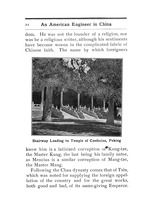 |
Page 22
“...22 An American Engineer in China
dom. He was not the founder of a religion, nor
was he a religious writer, although his sentiments
have become woven in the complicated fabric of
Chinese faith. The name by which foreigners
Stairway Leading to Temple of Confucius, Peking
know him is a latinized corruption o -tze,
the Master Kung, the last being his family natne,
as Mencius is a similar corruption of Mang-tze,
the Master Mang.
Following the Chau dynasty comes that of Tsin,
which was noted for supplying the foreign appel-
lation of the country and for the great works,
both good and bad, of its name-giving Emperor....”
|
|
| 17 |
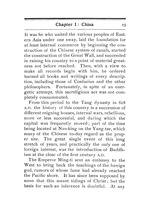 |
Page 23
“...Chapter I : China
23
It was he who united the various peoples of East-
ern Asia under one sway, laid the foundation for
at least internal commerce by beginning the con-
struction of the Chinese system of canals, started
the construction of the Great Wall, and succeeded
in raising his country to a point of material great-
ness not before reached. Then, with a view to
make all records begin with him, he ordered
burned all books and writings of every descrip-
tion, including those of Confucius and the other
philosophers. Fortunately, in spite of an ener-
getic attempt, this sacreligious act was not com-
pletely consummated.
From this period to the Tang dynasty in 618
a.d. the history of this country is a succession of
different reigning houses, internal wars, rebellions,
more or less successful, and during which the
capital was frequently moved ; part of the time
being located at Nan-king on the Yang-tze, which
many of the Chinese to-day regard as the prop-
er site. The great single event...”
|
|
| 18 |
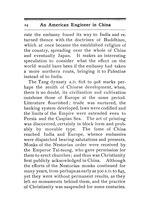 |
Page 24
“...24
An American Engineer in China
rate the embassy found its way to India and re-
turned thence with the doctrines of Buddhism,
which at once became the established religion of
the country, spreading over the whole of China
and eventually Japan. It makes an interesting
speculation to consider what the effect on the
world would have been if the embassy had taken
a more northern route, bringing it to Palestine
instead of to India.
The Tang dynasty a.d. 618 to 908 marks per-
haps the zenith of Chinese development, when,
there is no doubt, its civilization and cultivation
outshone those of Europe at the same period.
Literature flourished; trade was nurtured, the
banking system developed, laws were codified and
the limits of the Empire were extended even to
Persia and the Caspian Sea. The art of printing
was discovered, certainly in block form and prob-
ably by movable type. The fame of China
reached India and Europe, whence embassies
were dispatched bearing salutations and presents.
Monks of...”
|
|
| 19 |
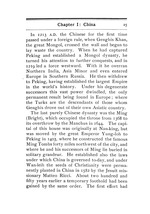 |
Page 25
“...Tombs forty miles northwest of the city, and
where he and his successors of Ming lie buried in
solitary grandeur. He established also the laws
under which China is governed to-day, and under
Wan-leih the seeds of Christianity were perma-
nently planted in China in 1582 by the Jesuit mis-
sionary Matteo Ricci. About two hundred and
fifty years earlier a temporary foothold had been
gained by the same order. The first effort had...”
|
|
| 20 |
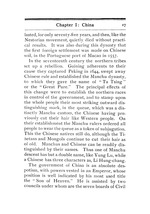 |
Page 27
“...Chapter I : China
27
lasted, for only seventy-five years, and then, like the
Nestorian movement, quietly died without practi-
cal results. It was also during this dynasty that
the first foreign settlement was made on Chinese
soil, in the Portuguese port of Macao in 1557.
In the seventeenth century the northern tribes
set up a rebellion. Gaining adherents to their
cause they captured Peking in 1644, swept away
Chinese rule and established the Manchu dynasty,
to which they gave the name of Ta Tsing"
or the Great Pure." The principal effects of
this change were to establish the northern races
in control of the government, and to stamp upon
the whole people their most striking outward dis-
tinguishing mark, in the queue, which was a dis-
tinctly Manchu custom, the Chinese having pre-
vious^ cut their hair like Western people. On
their establishment the Manchu rulers ordered all
people to wear the queue as a token of subjugation.
This the Chinese natives still do, although the Ti-
betans and...”
|
|
|